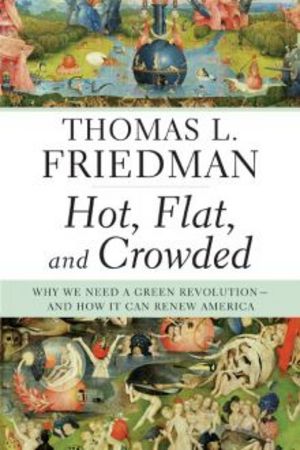Thomas L. Friedman has become synonymous with his term for how the world is becoming economically more even, or as he calls it “flattening.” In his newest book, Hot, Flat, and Crowded, he details what he perceives as the biggest crisis in American history and explains so thoroughly and with much ease. Friedman leaves no stone unturned in his 412 page best seller as he explores many different angles involving the three pronged problem affecting the global population.
The three problems he sees facing the globe, and further America, are globalization, which he describes as flattening, global warming, hot, and population growth, crowded. Friedman bundles all three and attempts to show the connections between them through a four part sequence. He does so by demonstrating cause, effect, resolution and consequence in that order.
Following that sequential order Friedman starts his book detailing the cause aspect of his argument. He begins by explaining what he means when writes “flat.” This topic, being the same as his previous book The World Is Flat, is one he stresses largely as he views it as one largely forgotten about in today’s discussions. He emphasizes globalization’s contribution to global warming, more people working equals more people consuming, and problems for the United States. He argues that because the U.S. is no longer alone at the top of the food chain, which now resembles more of a food pantry shelf with plenty of room, Americans are falling stagnant in their development while watching their jobs being swept from underneath their feet. This is all happening while the country is shipping their money at a vertical rate to oil-rich countries, some of which we are now at war with. Friedman’s overall argument here is if America wishes to maintain its stronghold on the command of the worldwide economic policies, it must do so by investing in the future through clean energies, or as he calls it ET, meaning renewable environmental technologies.
Next, Friedman details how the earth’s crowding, or the exponential population growth, has also increased the mess America finds itself in. He states that not only are there more consumers but there are more consumer’s consuming, at American type rates, the spread of western culture. He tells the readers to take oil for example. For the most part, despite OPEC’s attempt at control, supply stays mostly invariable/ But with the already substantial, and ever increasing, demand, prices are soaring, putting more than a dent in American’s wallets. Again he shows that not only are American’s paying more now but the excess they are spending is being sent out of the country.
The most controversial part of Friedman’s argument comes with his assertion that global warming is contributing to America’s stagflation. This is mostly controversial because many disagree with the fact of global warming at all, so how could it affect us? He answers this question by citing many sources, including scientists who he writes have scientifically proven global warming. He also rebuts that if global warming is a hoax it’s the greatest hoax ever perpetrated because it will help us grow out economy back to size, return to economic superiority and free us from the reigns of oil yielding countries.
Finally, Friedman goes in depth into how this problem facing the world and America can help spark a fire underneath the U.S.’s economy and start a new business sector. He does so by explaining the parallels between how the information technology revolution started and how the energy technology revolution currently is and will be started. Although there are hurdles he states, as he points out that the people that will most likely be affected by climate change will not be us which hurts our motivation. He does inject that it is unlikely that we will completely run out of energy resources, but he counters that by stating the Stone Age did not end because the world ran out of stones. Bringing the book around in a circle he details how the up and coming powers such as China must not follow in America’s energy guzzling footsteps, when he quotes a young Chinese man who says that America has been living high for 150 years and that now it is China’s turn to consume at a reckless pace. Continuing on with the China theme, Friedman wonders what it would be like to be China for a day and sign in to law new rules that would better suit the environmental movement, as he showed how overseas they, by mandate, got rid of every single plastic grocery bag in stores. Friedman’s last piece of business comes in the final chapter where his exiting message is that no longer should we shape up and green our planet for the good of other species, but that it is now time we must do it for the benefit of ourselves.
Reference:
- www.thomaslfriedman.com/bookshelf/hot-flat-and-crowded
- www.amazon.com/Hot-Flat-Crowded-Revolution-America/dp/0374166854
